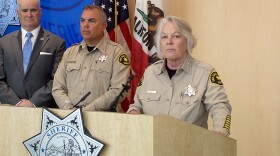Nature usually recovers after extreme weather conditions. Sometimes it gets overwhelmed. The environment it's change permanently. That is what a new survey of tree die off this finding in Southern California. The alarming number of dead and dying trees is signaling a fundamental change in our urban tree canopy and the drought is only partly to blame. Greg McPherson is a research Forester. He is joining us now. Will come to the program. Thank you. Can you explain the scope of this problem? Where is the style happening? Pretty much from the border north into San Fernando Valley. There has been some into Riverside in Santa Barbara. How many trees are at risk like There are about 70 million trees in this portion of Southern California. Sweaty -- 27 -- 27 million are at risk. That is 38%. It is that large because there are a number of different species of trees that are host to this including oaks and sweet gums which are quite abundant in urban communities. You are talking about a tiny insect, that has infested some of these trees and caused them to die. Out of these insects kill trees? Date have very tiny pinprick holes. Many of them will bore into the trunk and they will transmit a fungus that interrupts the flow of nutrients and water within the tree. That -- they will breed and then they will come out and invest other trees Why are they so hard to eradicate? They hide out in the core of the tree. They hard to get to. Then they fly and they can fly quite a distance. Once they are airborne, who knows where they will land? Did the drought speed up this urban tree loss? It may have contributed to it. It has added stress that may predispose trees to borers and other kinds of disease and pest. When we're talking about 38% of the trees that we state in our urban areas, cities parks the neighborhoods, that changes the environment, doesn't it? Yes. If all of those trees were to succumb we would lose about $1.5 billion in nature services annually. Those trees provide that. They have a great impact on property values and reducing air-conditioning costs because of cooling, they take air pollutants out of the atmosphere. They are not only making our cities more livable, they are improving the environment. People look at the trees and think these are mature permanent parts of the landscape but they are really pretty federal. We can lose in a matter of years what has taken generations to create. What can be done to help trees infested with various species of four insects? If someone suspects that there are little holes, they could go to PS AGB.org and take a look at the information. The best thing people can do is keep their health bash healthy. Then we need to think about planting species of trees to replace the that will be more resistant to the past and tolerant to drought and heat in extreme wins and the type of conditions that we are both likely to seek not just tomorrow but in the next 10 to 20 years. We have climate ready tree study. The purpose is to shift the power from trees. Those trees that we have are not adapted to the stressors, he, drought, when, past, that we will see in the future. We would like to introduce more resilient species. We have identified promising trees that are not available in local nurseries and not grown. We have twenty-year evaluations -- evaluation where we planned these trees and parks and reference sites. We measure them every year and record their performance growth and survival and maintenance requirements. We will be able to say whether these are good trees to plant for the future or whether they should be avoided. Is that what your report is urging the state to do about this? To really start to address this by removing dead trees and plantings new species of trees to replace them? I think it is all about managing the past and avoiding eight catastrophic loss of tree canopy. If we don't provide the resources we need, it would be good to have a gradual transition to a better adapted, more resilient landscape in the future then to tragically lose a lot of trees at one time. I have been speaking with Greg McPherson with the U. S. forest service. Thank you. Thank you, marring. -- marring.
Researchers from the U.S. Forest Service are documenting what they are calling an unprecedented die-off of trees in urban areas across Southern California.
Sycamores, willows, avocado and citrus trees are dying because of the drought, pests and disease infestations.
Greg McPherson, a supervisory research forester with the Forest Service, estimates that a pest called the polyphagous shot hole borer beetle alone could kill 27 million trees across the region. That is about 40 percent of the area’s 70 million urban trees.
McPherson joined Midday Edition Wednesday to talk about the environmental and economic impacts of California’s tree die-off.






